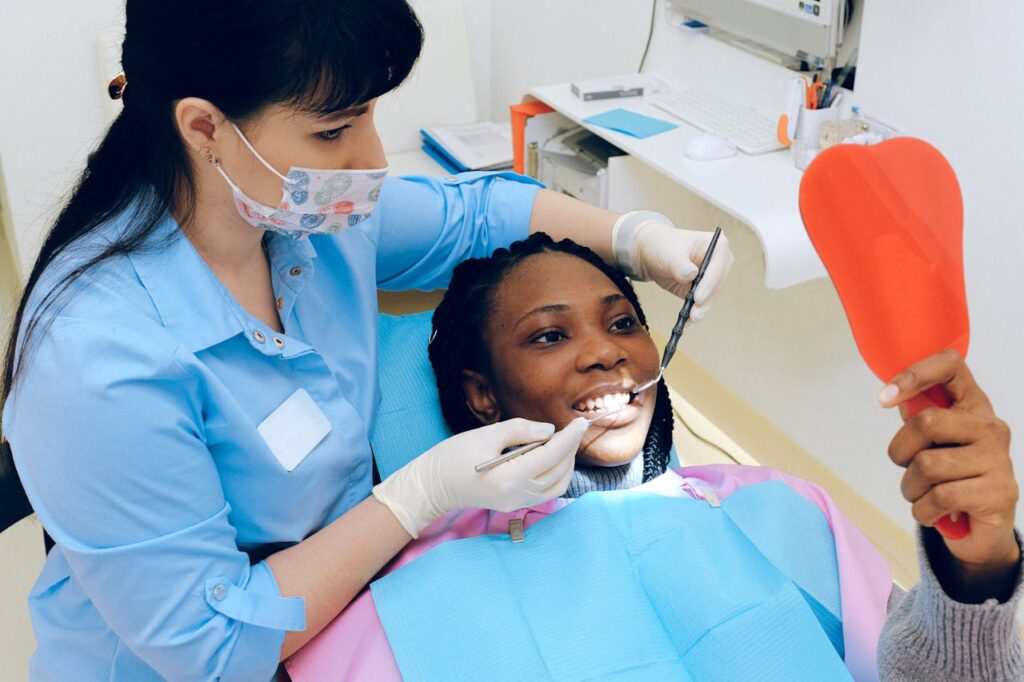
Gender, race, and ethnicity may be missed opportunities to explore how social identity components can hinder dental service utilization. Recognizing the psychosocial benefits of oral health and the importance of maintaining healthy teeth requires insight and empathy beyond acknowledging some of the better-known barriers like insurance coverage and proximity to dental providers.
Given that minority groups, often underrepresented, frequently experience poorer oral health outcomes [1], an understanding of the factors that directly and indirectly contribute to a person’s oral health status requires both astuteness and empathy. Lower income levels and minority populations, including immigrants and rural communities, tend to exhibit poorer oral health, as evidenced by self-reported oral health, toothache, adult tooth loss, and reduced dental care in the United States [2].
Postgraduate Degree in Community Oral Health
Like what you’re learning? Consider enrolling in the Herman Ostrow School of Dentistry of USC’s online, competency-based certificate or master’s program in Community Oral Health.
Dental service utilization requires individuals to feel psychologically ready for dental care [3]. An often overlooked reason for the underutilization of dental services is dental anxiety, particularly among underrepresented individuals. However, the anxiety these individuals feel deviates from more commonly known dental fears [4]; rather, it stems from concerns about receiving inferior care based on their identity [1], [5].
A Contributing Factor to Unmet Dental Care Needs
Unmet dental healthcare needs are not just clinical issues; they are deeply rooted in the socio-economic and racial fabric of our society, affecting primarily racial and ethnic minority groups in the United States. This reality brings to light the pervasive issue of dental fear and anxiety, which is notably more prevalent among these communities. Such fears are not unfounded but stem from systematic disparities and personal experiences of discrimination within healthcare settings.
Drawing from the article [3], the study provides an important perspective on the influence of perceived racial discrimination on dental anxiety experienced by ethnic populations. The study offers broader implications for understanding how racism impacts health outcomes across ethnic minorities and offers a model of how psychosocial factors influence health behaviors and outcomes.
The research provides insight into how African Americans who frequently encounter everyday racism or significant lifetime experiences of discrimination report 17.8% dental anxiety, which is disproportionately higher than other White US-based samples. This heightened anxiety is not merely about fear of the dental procedures themselves but also concerns over the quality of care and potential racial bias from healthcare providers. Recent research [6] explained the profound impact of racial discrimination within oral healthcare.
This study indicates that over one-third of African American women have encountered racism in dental settings, often feeling disregarded by healthcare providers due to their race. The anticipation and pattern of discriminatory treatment can lead to a reluctance to seek care, resulting in a detrimental cycle where avoidance of dental visits leads to poorer oral health, which not only perpetuates oral health disparities but also calls for an immediate response from the healthcare sector.
Such findings indicate the importance of dental care providers’ need and want to adopt more culturally competent practices and actively dismantle racism in the healthcare setting. These practices should also acknowledge the presence of healthcare-related anxieties in minority populations and actively work to create an environment that feels safe and inclusive. This approach requires a systematic change in dental care approaches, focusing on building trust and understanding these communities’ unique challenges.
Conclusion
In oral healthcare, every patient transcends their race, age, gender, or any singular characteristic [7]. By recognizing and embracing the entirety of each person, the unified effort of dental teams responds to diverse health needs and concerns [7]. Dental clinicians undergo extensive education and training in behavioral sciences and possess sophisticated skills that are putting an end to this type of antiquated ideology that has no place in contemporary society[8]. Furthermore, dental care has never been more compassionate and advanced.
Earn an Online Postgraduate Degree in Community Oral Health
Like what you’re learning? Consider enrolling in the Herman Ostrow School of Dentistry of USC’s online, competency-based certificate or master’s program in Community Oral Health.
References
- V. Elaine Muirhead, A. Milner, R. Freeman, J. Doughty, and M. E. Macdonald, “What is intersectionality and why is it important in oral health research?,” Community Dentistry and Oral Epidemiology, vol. 48, no. 6, pp. 464–470, 2020, doi: 10.1111/cdoe.12573.
- J. L. Bastos, H. M. Constante, H. S. Schuch, D. G. Haag, and L. M. Jamieson, “The Mouth as a site of compound injustices: A structural intersectionality approach to the oral health of working-age US adults,” American Journal of Epidemiology, vol. 192, no. 4, pp. 560–572, 2023, doi: 10.1093/aje/kwac205.
- B. Heaton, J. C. Bond, J. Bae, and Y. Cozier, “Perceived experiences of racism linked to dental fear and anxiety among Black women,” Community Dentistry and Oral Epidemiology, vol. 51, no. 5, pp. 896–907, 2023, doi: 10.1111/cdoe.12782.
- C. H. Winkler, M. Bjelopavlovic, K. M. Lehmann, K. Petrowski, L. Irmscher, and H. Berth, “Impact of Dental Anxiety on Dental Care Routine and Oral-Health-Related Quality of Life in a German Adult Population—A Cross-Sectional Study,” Journal of clinical medicine, vol. 12, no. 16, pp. 5291-, 2023, doi: 10.3390/jcm12165291.
- D. L. Patrick, R. S. Y. Lee, M. Nucci, D. Grembowski, C. Z. Jolles, and P. Milgrom, “Reducing oral health disparities: A focus on social and cultural determinants,” BMC Oral Health, vol. 6, no. 1, pp. S4–S4, 2006, doi: 10.1186/1472-6831-6-S1-S4.
- K. C. Sokoto et al., “Racism in oral healthcare settings: Implications for dental care‐related fear/anxiety and utilization among Black/African American women in Appalachia,” Journal of Public Health Dentistry, vol. 82, no. 1, pp. 28–35, 2022, doi: 10.1111/jphd.12523.
- M. R. Inglehart, J. Albino, J. S. Feine, and C. Okunseri, “Sociodemographic Changes and Oral Health Inequities: Dental Workforce Considerations,” JDR clinical and translational research, vol. 7, no. 1_suppl, pp. 5S-15S, 2022, doi: 10.1177/23800844221116832.
- S. E. Raskin, M. Thakkar-Samtani, M. Santoro, E. B. Fleming, L. J. Heaton, and E. P. Tranby, “Discrimination and dignity experiences in prior oral care visits predict racialized oral

